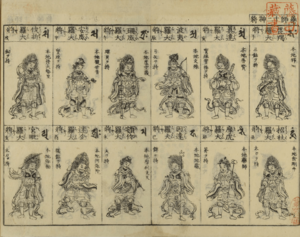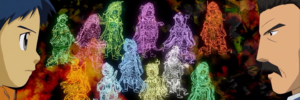Deva
The Deva (十二神将, Jūni Shinshou; lit. "Twelve Heavenly Generals"; alternatively 十二神, Jūnishin; lit. "Twelve Deities") are a group of twelve Perfect Digimon who serve the Four Holy Beasts.
Overview[edit]
The Four Holy Beasts are each served by three of the Deva. Each Deva shares the Attribute of the Holy Beast that they serve. The only potential exception is Andiramon, who exists in both Virus and Data variants, but serves the Data Attribute Qinglongmon (although it is usually the Data variant of Andiramon who is associated with the Deva). Typically in a crisis, the Holy Beasts will first send the Deva to address the situation; if the Deva are unable to handle it, only then will the Holy Beasts themselves get involved.[1] Their personalities and skill set are often influenced by the Holy Beast whom they serve.[2]
The Deva have their own individual specialties and strengths:
- Vajramon has the most developed physical strength.[3]
- Mihiramon is the biggest ruffian.[4]
- Sandiramon is the most cunning and cruel.[5]
- Sinduramon has the hardest armor.[6]
- Pajiramon holds a surprisingly high number of secrets whose truth is not divulged, and because of this it holds the alias of "Dark Deva".
They also hold different relationships to each other:
- Indaramon and Vajramon are on especially bad terms with each other due to their conflicting beliefs and personalities.[3][7]
- Caturamon cares for Makuramon and Sinduramon (all three serve Baihumon) as if they were its younger brothers. They do not reciprocate this. It also acts as a moderator when its comrades quarrel.[8]
- Pajiramon is a loner who does not care for others, and makes no effort to befriend the other Deva.[9] Only one Deva is able to counter the power of Pajiramon's Vahnijvala: Kumbhiramon, through the power of its thoughts.[9]
Design and Analysis[edit]
Each Deva is based on and named after one of the Twelve Heavenly Generals, a group of Hindu Yakṣa (a term in which the group are also referred to collectively as) who were incorporated into Buddhist mythology as the servants and protectors of the Bhaiṣajyaguru. The term "Deva" itself refers to the plethora of deities and other supernatural beings that the Twelve Heavenly Generals belong to.
In Japan, by the end of the Heian Period, it became common in Japanese Buddhism to represent the Heavenly Generals as animals of the Chinese zodiac. The Deva Digimon follow this tradition and are each themed after one of the animal of the Chinese Zodiac. However, over the years there have been multiple proposed schemes of which Heavenly General is associated with which Zodiac animal, and different depictions may feature different assignments. The Deva's animal assignments follow one such scheme.[10]
Another major source of inspiration for the Digimon depiction of the Deva is the Butsuzōzui (佛像圖彙), an illustrated compendium of Buddhist images that was originally published in three volumes in 1690 which categorized and organized deities, including the Twelve Heavenly Generals (artwork from the Butsuzōzui was used in the Digimon Tamers episode "I Want to Become Strong! Rise, Impmon" when Lee Jianliang and Chou-sensei discuss the mythological inspiration behind the Deva Digimon). Nearly all of the Deva have three horns and red eyes, and each wears Chinese-styled armor with a red or purple scarf.
Each Deva also has one of the following:
- A Special Move that is named after one of the twenty-eight Naraka, or "hells" mentioned in the Viṣṇu Purāṇa. Usually, the chosen Naraka has some association with either the Deva's zodiac animal or their weapon, through the literal meaning or description of that Naraka.
- A bīja, written in Siddhaṃ script, inscribed somewhere on their armor. In a similar manner to the Chinese zodiac, the Twelve Heavenly Generals were also assimilated into the Honji suijaku paradigm where they were seen as local manifestations of eternal Buddhist figures. Those figures, consisting of a mixture of Buddhas and Bodhisattvas, were referred to as "honji" (本地) or "honjibutsu" (本地仏). Although the honji and the generals that are assigned to them are not always consistent, in the case of the Deva, their designations are based on those displayed in the Butsuzōzui. Almost all of the bījas coupled with each general correspond to the ones that are associated with the honji to which they are assigned.
- A signature weapon which is named in Chinese in the format Bǎo (X) 「宝(X)」, where (X) is a generic type of weapon that represents a lakṣaṇa, the hand-held attribute of a Buddhist image. This is also a reference to the fact that Yakṣa were the guardian deities of the treasure hidden in the earth in Hindu mythology. The configuration of the weapons that the Twelve Heavenly Generals wield vary in different media, and the weapons that the Deva use are concatenated from those media, primarily the Butsuzōzui.
In general, the Deva take their weapons, bīja, and honji from those associated with the Heavenly Generals in the order in which they are listed in the Butsuzōzui order (there are some exceptions where the Deva use different weapons or bīja entirely). However, they take their names from the Sanskrit names of the Twelve Heavenly Generals in the Butsuzōzui order in reverse. They take their associated animal species from the signs of the Chinese zodiac, in order.
Members[edit]
| Deva | Servant of | Mythological inspiration | |||||||||
|---|---|---|---|---|---|---|---|---|---|---|---|
| Namesake Heavenly General | Sign | Special Move/Naraka | Weapon | Bīja | Honji | Notes | |||||
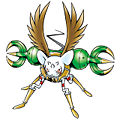 Kumbhiramon |
Xuanwumon | Rat | Krimíśa ("hell of insects") |
Bǎo Chǔ Pestle/vajra |
|
Śākyamuni (Shaka) |
Weapon, bīja, and honji all traditionally associated with Vikarāla (the first of the Heavenly Generals in the order in which they are listed in the Butsuzōzui). Specifically, Vikarāla is associated with a three-pronged vajra (三鈷 sanko). | ||||
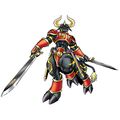 Vajramon |
Xuanwumon | 伐折羅大将 Basara-taishō |
Ox | Rodha ("obstruction") |
Bǎo Jiàn Sword |
Vajrapāṇi (Kongousha) |
Weapon, bīja, and honji all traditionally associated with Catura (the second in the Butsuzōzui order). Only the hūṃ bīja has that historical association, not the va bīja on Vajramon's Bǎo Jiàn. | ||||
 Mihiramon |
Qinglongmon | Tiger | Vimohana ("place of bewildering") |
Bǎo Bàng Three-section staff |
|
Samantabhadra (Fugen) |
Weapon, bīja, and honji all traditionally associated with Sindūra (the third in the Butsuzōzui order). | ||||
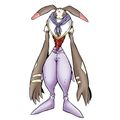 Andiramon |
Qinglongmon | Anchira-taishō |
Rabbit | Asipatravana ("forest of sword leaves") |
Bǎo Fǔ Axe |
|
Bhaiṣajyaguru (Yakushi) |
Weapon, bīja, and honji all traditionally associated with Makura (the fourth in the Butsuzōzui order). | |||
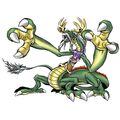 Majiramon |
Qinglongmon | 末儞羅大将 Manira-taishō 頞儞罗 È'nǐluó |
Dragon | Vedhaka ("piercing", the hell of arrow manufacturers) |
Bǎo Shǐ Arrow |
|
Mañjuśrī (Monju) |
Honji is traditionally associated with Pāyila (the fifth in the Butsuzōzui order). Pāyila is also traditionally associated with arrows as well as bows. The bīja that is traditionally associated with Pāyila, | |||
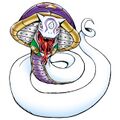 Sandiramon |
Zhuqiaomon | Sanchira-taishō |
Snake | Krishńa ("dark") |
Bǎo Kuí Lance |
|
Kṣitigarbha (Jizou) |
Weapon, bīja, and honji all traditionally associated with Indāla (the sixth in the Butsuzōzui order). | |||
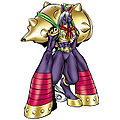 Indaramon |
Zhuqiaomon | Horse | Adhomukha ("head-inverted") |
Bǎo Bèi Conch shell |
|
Ākāśagarbha (Kokūzou) |
Weapon, bīja, and honji all traditionally associated with Śaṇḍilya (the seventh in the Butsuzōzui order). | ||||
 Pajiramon |
Zhuqiaomon | Sheep | Vahnijwala ("fiery flame"; the hell of shepherds) |
Bǎo Gōng Bow and arrow |
|
Mārīcī (Marishi-ten) |
Bīja and honji are traditionally associated with Majira (the eighth in the Butsuzōzui order). Majira is also traditionally associated with arrows, but not bows. | ||||
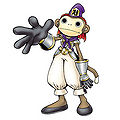 Makuramon |
Baihumon | Makora-taishō |
Monkey | Raurava ("fearful") |
Bǎo Yù Ball |
|
Avalokiteśvara (Kanzeon) |
Weapon, bīja, and honji all traditionally associated with Aṇḍīra (the ninth in the Butsuzōzui order). | |||
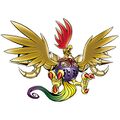 Sinduramon |
Baihumon | Rooster | Púyaváha ("where matter falls") |
Bǎo Chǔ Pestle/vajra |
|
Amitābha (Amida) |
Weapon, bīja, and honji all traditionally associated with Mihira (the tenth in the Butsuzōzui order). Specifically, Mihira is associated with a single-pronged vajra (独鈷 tanko). | ||||
 Caturamon |
Baihumon | 招杜羅大将 Shōtora-taishō |
Dog | Śwabhojana ("food of dogs") |
Bǎo Chuí Hammer |
|
Mahāsthāmaprāpta (Tokudaiseishi) |
Honji is traditionally associated with Vajra (the eleventh in the Butsuzōzui order). Catura is traditionally associated with swords, and none of the Heavenly Generals have an association with hammers. The bīja that is traditionally associated with Vajra, | |||
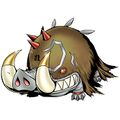 Vikaralamon |
Xuanwumon | Bikara-taishō |
Pig | Súkara ("hog") |
Bǎo Lún Wheel |
|
Maitreya (Miroku) |
Bīja and honji are traditionally associated with Kumbhīra (the twelfth in the Butsuzōzui order). Vikarāla is traditionally associated with swords, and none of the Heavenly Generals have an association with wheels, although they do have significance as Buddhist iconography. | |||
Appearances[edit]
Anime[edit]
Digimon Tamers[edit]
- Main article: Deva (Tamers)
All twelve Deva are servants of Zhuqiaomon and (with one exception) minor antagonists. According to Lopmon (formerly Andiramon of the Deva), Zhuqiaomon created the Deva by reconfiguring the "fragments of Digimon that became dust". It commands the Deva with retrieving Culumon and eliminating potential threats to the Four Holy Beasts,[11] so they begin Realizing into the real world to try and capture Culumon, but are resisted by the Tamers.
Of the Deva, Andiramon is the only one who does not appear to have been ordered to pursue Culumon. Instead, he guards the Southern Gate of the Four Holy Beasts' domain, until he defects and becomes Lee Shaochung's partner Digimon.[12]
The episode "I Want to Become Strong! Rise, Impmon" explores the mythological inspiration of the Deva. Lee Jianliang asks his martial arts instructor, Chou-sensei, about the meaning of the term "Deva". Chou-sensei discusses the role of the Deva in Hinduism as enemies of the Asura, and reflects on the subjective nature of good and evil as it relates to the perception of the Deva as "good" gods. This scene uses illustrations of the Twelve Heavenly Generals that are taken from the Butsuzōzui.
Manga[edit]
Digimon Knuckles[edit]
The Deva are a group of Digimon with high status as prestige, though not as high as the Royal Knights. Vajramon and Pajiramon are members of the group, and them falling under the control of the mysterious villain was taken as proof of how dangerous that being was.
Video Games[edit]
Digimon World Re:Digitize[edit]
The Deva appear as collectable cards.
Digimon World Re:Digitize Decode[edit]
The Deva appear as collectable cards.
Digimon Story: Cyber Sleuth[edit]
After Aiba collects all of the Deva medals, the Medal Man rewards them with 3 Revival Capsule DX.
Digimon Story: Cyber Sleuth Hacker's Memory[edit]
After Amasawa Keisuke collects all of the Deva medals, the Medal Man rewards him with with 3 Revival Capsule DX.
Digimon ReArise[edit]
Vikaralamon had travelled to the Human World to the ascertain the threat after a large quantity of devices affected the Digital World. Xuanwumon however considered it to just be a "passing noise" and so travelled to the Human World to retrieve its subordinate.
Vajramon, Kumbhiramon, Majiramon, Mihiramon, Pajiramon, Sinduramon, Caturamon, Sandiramon, Indaramon, Makuramon and Andiramon also appear.
Digimon New Century[edit]
TCG[edit]
Digimon Card Game[edit]
Deva is a trait given to the members of this group in the Digimon Card Game. While originally it had no gameplay implications, some cards released since EX-05 Animal Colosseum, such as those of the Four Holy Beasts, interact specifically with this trait.
